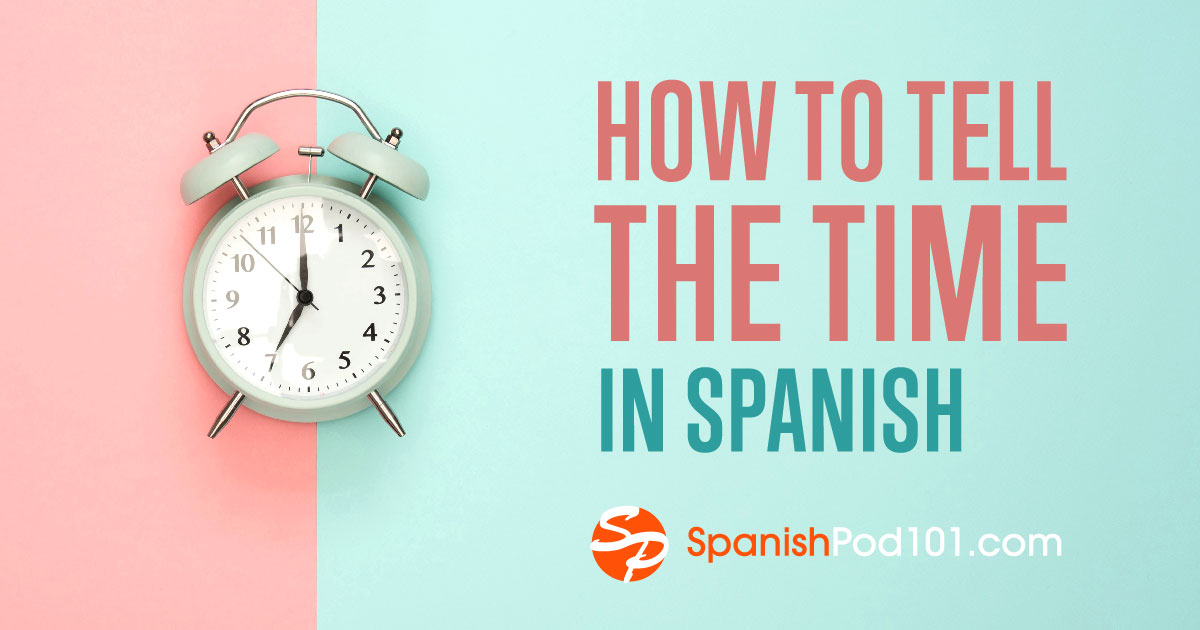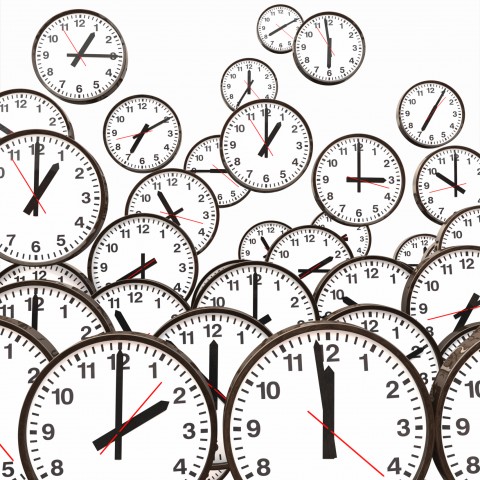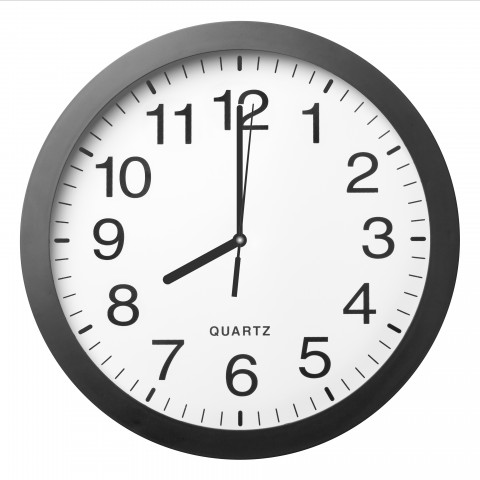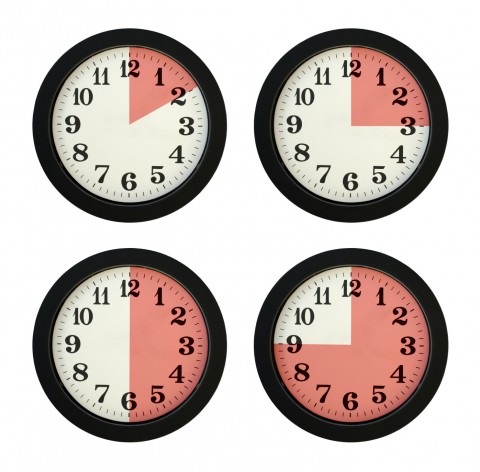
How do you say “time” in Spanish? And how do you say “What time is it?” in Spanish?
Did you know that to tell the time you should never use the literal translation, tiempo?
That’s just the tip of the iceberg, though. We’ll answer this and other questions more in-depth in this blog post! Learn everything about how to say the time in Spanish with SpanishPod101.com!
Learning about telling time in Spanish, along with how to introduce yourself in Spanish, is significantly important if you want to improve your conversation skills.
Even in your native language, knowing the right way of telling the time can help you avoid misunderstandings. Well, time is so crucial in Spanish culture that learning how to tell time is as important as time itself.
Let’s get started with our guide on time in Spanish for beginners!
 Table of Contents
Table of Contents
- How to Ask for the Time
- The Hours in Spanish
- The Minutes in Spanish
- Hours Divided into Minutes in Spanish
- General Time Reference of the Day
- Time Adverbs
- Time Proverbs and Sayings in Spanish
- Conclusion
1. How to Ask for the Time
Telling the time in Spanish is simple if you know the cardinal numbers and the verb “to be” (ser). Once you practice and master those two things, asking and telling the time in Spanish will be so much easier.

- ¿Qué hora es?
“What time is it?”
In some Latin American countries, you may hear ¿Qué hora son? instead of ¿Qué hora es?. Both are correct for asking the time in Spanish. The singular form is used mostly in Spain and the plural form is used mostly in Latin American Spanish-speaking countries.
- ¿Qué hora son?
“What time is it?”
To learn how to say the time in Spanish, you also need to know that “time” in Spanish is tiempo. Tiempo also means “weather,” but you never use tiempo to ask for the time.
- Hoy hace buen tiempo.
“Good weather today.”
To learn how to ask the time in Spanish, you just have to change the word “time” to the word for “hour.” So “What time is it?” would be translated as ¿Qué hora es? This is the easiest way to learn how to say time in Spanish. But there are some other ways of asking what the time is in Spanish, such as ¿Tienes hora? which means “Do you have the time?”
Another way to learn how to ask the time is by asking what time something is (e.g. a meeting, a concert, or work): ¿A qué hora es el concierto? To ask “At what time is,” in Spanish (e.g. “What time is the concert?”), notice that you have to add an a before qué, which means “at.”
Once you have these few things in mind, it will be so much easier for you to ask for the time in Spanish.
Asking correctly is as important as telling the time in Spanish. So let’s look at some formulas and tricks on how to say the time in Spanish in case you get asked.

Verb to be (Es / Son) + la(s) + number from one to twelve + number of minutes
- Es la una de la mañana.
“It is 1 a.m.”
OR
- Es la una en punto.
“It’s one o’clock.”
Es + la + una + y + number of minutes
- Es la una y treinta minutos.
“It’s 1:30 a.m.”
- Es la una y diez minutos.
“It’s 1:10 a.m.”
If you want to say any hour between two and twelve, you have to use the third person of the plural son, as follows:
- Son las tres de la mañana.
“It’s three a.m.”
If someone tells you the time, make sure you say “thank you,” and do it the right way.
2. The Hours in Spanish

If you can count from one to twelve, you’re already on the right path—cardinal numbers are essential for telling the time in Spanish. If you don’t know all of them yet, here you just need to know the numbers from one to twelve.
Uno — “One”
Dos — “Two”
Tres — “Three”
Cuatro — “Four”
Cinco — “Five”
Seis — “Six”
Siete — “Seven”
Ocho — “Eight”
Nueve — “Nine”
Diez — “Ten”
Once — “Eleven”
Doce — “Twelve”
Once you have these memorized, you can try using them in one of the formulas we’ve covered. Another thing to keep in mind when learning how to say “What time is it?” is that “o’clock,” which is en punto, doesn’t always need to be added.
Example:
- Son las ocho.
“It’s eight o’clock.”

- Son las ocho en punto.
“It’s eight o’clock.”
Easy peasy, right?
So, how do you know if it’s morning or evening?
When telling the time in Spanish, know that you don’t need to use a.m. or p.m. Although it’s correct to say, most Spanish speakers don’t use them. We prefer to say ocho de la mañana (“eight in the morning”) or diez de la noche (“ten in the evening”). However, when it comes to writing the time in Spanish, we use the twenty-four-hour clock (also known as military time).
However, this is very subjective because some of the Latin American countries aren’t used to using the twenty-four-hour clock and use a.m. and p.m. more often than in Spain.
The general rule in Spain is: Write in military time and speak the time as numbers from one to twelve. For example, if you’re going to a theater show, you’ll see the time on their page or billboard as follows:
22:30
But you’ll say to a friend by phone:
- Las diez y media de la noche.
“Ten thirty at night.”
For some Latin American countries, the night starts when it’s dark, around six p.m. This is because they’re near the equator, and thus the time the sun sets doesn’t change much during the summer.
For the Spanish, on the other hand, the night starts after eight p.m. “Six p.m.” is still seis de la tarde.
It’s important to remember then that the Spanish language is gendered. So, when learning about time in Spanish, you need to know that you should always use the feminine article –las because it refers to la hora. The only exception is when you’re talking about one o’clock, in which case you use la.
- Es la una en punto.
“It is one o’clock.”
- Son las tres de la tarde.
“It is three p.m.”
3. The Minutes in Spanish

When learning how to tell time in Spanish, there are multiple levels that you can aim for once you start using the minutes in Spanish. You can start with the easy formula of saying the number of minutes after the hour. To reach the highest level, use phrases such as “quarter to,” in Spanish, “quarter past,” “half,” or “minutes to (hour).”
An easy way to say the minutes in Spanish is to just say the number of minutes. But to make things simpler, let’s learn the minutes by fives:
2:05 Las dos y cinco
3:10 Las tres y diez
4:15 Las cuatro y quince
5:20 Las cinco y veinte
6:25 Las seis y veinticinco
7:30 Las siete y treinta
7:35 Las siete y treinta y cinco
8:40 Las ocho y cuarenta
9:45 Las nueve y cuarenta y cinco
10:50 Las diez y cincuenta
11:55 Las once y cincuenta y cinco
After the number of minutes, you can add the word minutos. It’s the translation for “minutes,” and you’ll always use this word in the plural unless you say “one minute” (y un minuto).
- Son las tres y cinco minutos.
“It is three and five minutes.”
- Son las doce y un minuto.
“It is one minute past twelve.”
4. Hours Divided into Minutes in Spanish
So one way of improving your level of Spanish is to expand on your knowledge of hours in Spanish. What do I mean? You can identify your level of Spanish by whether you’re able to understand and tell the time in Spanish by half, quarter, and three quarters of an hour.
How do we do this?
The same way we divide time in English. Dividing the clock into blocks of fifteen minutes. Every fifteen minutes, we’re talking about cuartos or “quarters.”

To talk about half an hour in Spanish, you need to use y media.
Unlike in English, in Spanish you say the hour first, then the minutes:
- 01:30 p.m.
La una y media.
“Half past one.”
To say that it’s a quarter past an hour in Spanish, you need to use y cuarto.
- 01:15 p.m.
Es la una y cuarto.
“It is a quarter past one.”
To say that it’s a quarter until an hour in Spanish, you need to use menos cuarto. This means that you tell the hour first, and then you have to take away the quarter from the time that’s approaching. It sounds like “one minus quarter” for 12:45 p.m.
Like in English, the Latin American Spanish-speakers use the phrase “quarter till” in a similar manner. It’s okay to use this, especially if you’re learning. Then, once you get a better understanding and you need to improve your Spanish skills, you can start telling time like Spaniards do.
Note that even for some Latinos it’s hard to tell the time the European Spanish way, so go easy on yourself!
Latin American Spanish:
- 01:45 p.m
Faltan un cuarto para las dos.
“It is a quarter to two.”
The most difficult to learn and remember is the quarter until an hour. This is because you may still be thinking it in the English way.
In English:
Minutes left to the time approaching + “to” + hour (from one to twelve)
Example:
01:45 p.m. — “A quarter to two.”
In Spanish:
Hour (from one to twelve) + menos + minutes left to the approaching time
Example:
01:45 p.m. — Las dos menos cuarto.
5. General Time Reference of the Day
As we said earlier, in Spanish we’re more used to saying “in the morning” or “in the evening” to refer to a.m. or p.m. While we do understand it if we see it, we don’t usually use these terms.
Instead, we use other words that refer to certain times of the day, and these will be very good for you to learn. Let’s take a look!
- Primera hora de la mañana — “Early morning”
Example:
Tengo cita en el médico a primera hora de la mañana.
“I have a doctor’s appointment in the early morning.”

- Amanecer — “Sunrise”
Example:
El amanecer más bonito que he visto nunca ha sido en Cádiz.
“The most beautiful sunrise that I’ve never seen was in Cadiz.”
- Mediodía — “Noon” or “Midday”
Example:
La clase acaba en el mediodía.
“The class ends at noon/midday.”
- Primera hora de la tarde — “Early afternoon”
Example:
¿Quedamos para el café a primera hora de la tarde?
“Shall we meet for coffee at early afternoon?”
- Noche — “Evening” or “Night”
Example:
¿Cuántas noches has tenido que trabajar esta semana?
“How many nights did you have to work this week?”
- Puesta de sol — “Sunset”
Example:
Me han contado que en Bali hay unas puestas de sol mágicas.
“I have been told that in Bali there are magical sunsets.”
- Medianoche — “Midnight”
Example:
Con 15 años mis padres me dejaban salir los fines de semana hasta medianoche.
“When I was 15 years old, my parents would let me go out on the weekends until midnight.”
6. Time Adverbs
In Spanish, we use adverbs of time, place, mode, or quantity all the time. With them, you add information to verbs, adjectives, and even to the whole sentence.
You’ll quickly become very familiar with them since they’re essential when you’re learning how to tell time in Spanish.
- Antes — “Before”
Example:
Kike, lávate las manos antes de comer.
“Kike, wash your hands before eating.”
- Después — “After”
Example:
Después de comer apetece una siesta.
“After eating, you want a nap.”
- Luego — “Later”
Example:
Llámame luego.
“Call me later.”
- Pronto — “Soon”
Example:
Te veo pronto.
“See you soon.”
- Tarde — “Late”
Example:
Se me está haciendo tarde para ir al supermercado.
“It’s getting late to go to the supermarket.”
- Temprano — “Early”
Example:
Hay que levantarse temprano para ir al colegio mañana.
“We have to wake up early to go to school tomorrow.”
- Todavía (This adverb has different meanings in English, depending on the time verb you’re using.):
– “Still”
– “Yet”
– “Even so”
Example:
Todavía estoy aquí esperándote.
“I am still here waiting for you.”
Example:
Todavía no he estado en París.
“I have not been to Paris yet.”
- Ayer — “Yesterday”
Example:
Ayer Luis me dejó esperando una hora en el café.
“Luis left me waiting for one hour in the coffee shop yesterday.”
- Hoy — “Today”
Example:
Tengo tres entrevistas de trabajo hoy.
“Today, I have three job interviews.”
- Mañana — “Tomorrow”
Example:
Sara, por favor, revisa mi agenda de mañana.
“Sara, check tomorrow’s agenda, please.”
- Antes de ayer o anteayer — “The day before yesterday”
Example:
Antes de ayer empecé con el entrenamiento.
“I started with my training the day before yesterday.”
- Pasado mañana — “The day after tomorrow”
Example:
Pasado mañana empieza el mes de julio.
“July starts the day after tomorrow.”
- Siempre — “Anytime”, “always,” or “forever”
The word “anytime” refers to “always” in terms of describing every time that something happens. But we translate the same word siempre, or with cada vez.
Example:
Siempre que Antonio va al parque se encuentra al gato perdido.
“Anytime Antonio goes to the park he runs into the lost cat.”
- “Always” is the most common way to translate siempre. It refers to “all the time” and “forever.”
Example:
Siempre te querré.
“I will always love you.”
- Nunca, Jamás — “Never”
Example:
Nunca más vuelvo a fiarme de un desconocido.
“I will never again trust a stranger.”
- Prontamente, Pronto — “As soon as possible”
Example:
Ven a recogerme pronto.
“Come and pick me up as soon as possible.”
- En un rato – “In a little while”
Example:
Estaré preparada en un rato.
“I’ll be ready in a little while.”
7. Time Proverbs and Sayings in Spanish
If you want to sound like a Spanish native, idioms and expressions are the best way to show off. However, it’s important that you know when and how to use them, or it can have the opposite effect!
Some great phrases for latecomers include Voy en camino (“I’m on my way”) and Llego tarde (“I’m late” or “I’m running late”). These are great to send by text so you don’t keep people waiting.

The expressions “time is money” and “time flies” refer to moments in which time goes fast and you have to take advantage of it. Their translations are el tiempo es dinero and el tiempo vuela respectively.
Other common expressions in Spanish are:
- El tiempo cura las heridas. — “Time heals all wounds.”
- Más vale tarde que nunca. — “Better late than never.”
- A quien madruga, Dios le ayuda. — “The early birds get God’s help.”
8. Conclusion

So, reader, do you feel more confident about telling time in Spanish now? In the comments below, tell us what time it is where you are, in Spanish!
Next time you’re late to an appointment or want to ask someone on a date, you can come back to this page for help setting up times or letting someone know you’re almost there. You can use all of our fun lessons, idiomatic expressions, and more resources at our SpanishPod101 website.
SpanishPod101 has many vocabulary lists for you for free, and of course, our Spanish Resource Corner for any other questions you may have. Why don’t you practice your Spanish by asking other Spanish speakers what they’re up to?
Happy Spanish learning! 🙂










